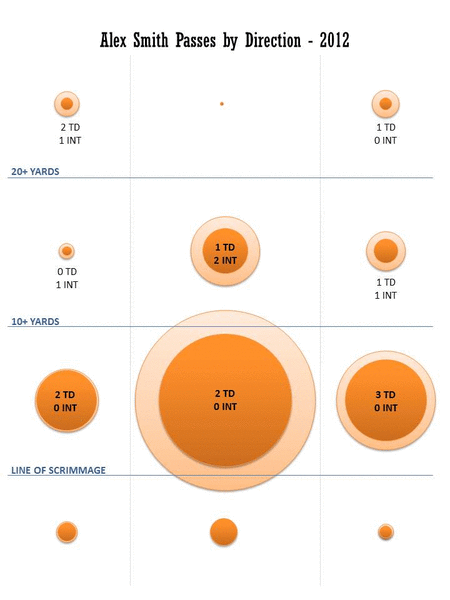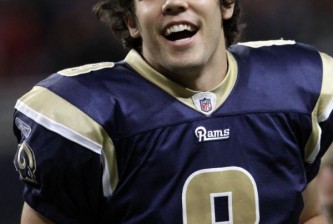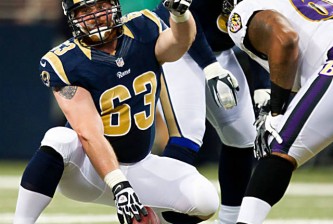
In less than two years, Jim Harbaugh has made the San Francisco 49ers into one of the NFL's premier division bullies, rivaling only the Patriots and Ravens (coached by his brother John) for their level of domination of their own division. Combined, the three teams have lost only two games to their rival teams.
At quarterback, these three teams couldn't be more different. In Tom Brady, the Patriots have one of the game's elite quarterbacks; in Joe Flacco, the Ravens have a big-armed monster that is becoming more dangerous as a passer; in Alex Smith, the 49ers have … Alex Smith.
By far the most impressive job Jim Harbaugh has done in San Francisco is in turning Smith into a usable – even valuable – commodity in the passing game. Every other component of the 49ers' success – a punishing defensive front, near-elite weapons in Vernon Davis and Frank Gore – was inherited. So much so that only one draft pick from Harbaugh's two seasons as coach – Aldon Smith – has cracked the starting rotation.
So how has he done it? And what can the Rams learn from his approach?
The 49ers' Approach: Keep It Simple, Stupid
A look at Alex Smith's target depth from 2010 – when he was still a "bust" – and this season shows an emphasis on efficiency, mainly by eliminating opportunities for Smith to make mistakes. Under Harbaugh, Smith has set 49er records for TD-to-INT ratios, and is throwing by far his best completion percentage of his career.
There is a simple factor at play here – the deep throw has been all but erased from the playbook. WIth a strong offensive line to work with, Harbaugh apparently doesn't care a whit about "keeping defenses honest" or "opening holes for the run game" by chucking the ball deep on a regular basis. (The 49ers employ not one but two offensive line coaches, retaining Mike Solari from the Mike Singletary years and bringing personal favorite Tim Drevno aboard from Stanford.)
Additionally, the Niners have gotten much more efficient at short throws outside the stripes, as you can see from Smith's vanishing incompletions in the 2012 chart. This is likely due to Harbaugh's simplified read-based passing offense. The biggest simplification of all, explains Smart Football's Chris Brown? Eliminating "sight reads" against the blitz.
This is not to say that sight adjustments can't work, but they're certainly difficult to execute, and when they go wrong terrible things happen: Receivers run hot routes they shouldn't, or don't run them when they should; passes go sailing to empty patches of green; interceptions are frequent.
Rather than make the hot route an optional play that requires "an almost telepathic relationship between quarterback, receiver, and the offensive line," Harbaugh simply bundles a makeable short pass into every offensive play call.
It doesn't show up in the chart, but there is a third factor at play here as well. If the easy read isn't there, suddenly you have a vanishing likelihood of a good play happening balanced against a series of bad outcomes – an incomplete pass, an interception, or a sack. And in this offense, Smith is much more likely to take the sack than let the ball go and have something bad happen. Just like Jim Harbaugh was when he played.
The Rams' Approach: Stretch the Field

Where the secret to making Alex Smith productive has been about transforming him into a "game-manager" (Smith simply does not show up on the fantasy football radar), the Rams have been taking an opposite approach with Bradford this season. They are calling on him to throw the ball all over the field. Bradford has more throws of 20+ yards, and more throws behind the line of scrimmage, than Smith this season. In short, the Rams are asking Bradford's depth of field to be the entire field.
To some extent, the Rams have found some success with this approach, particularly in establishing Chris Givens as a legitimate deep threat. As you can see, more than half of Bradford's scoring passes have come on throws of 10+ yards, compared to 41% for Smith.
But you can also see a disturbing amount of incompletions in Bradford's must-make passes inside ten yards from the line of scrimmage. While both teams have asked their quarterbacks to move the chains, it is Smith's only mandate in the passing game. And both by design and by execution, the 49ers are simply better at it than the Rams. Just compare these 2012 numbers vs the blitz:
Smith (82 dropbacks): 47-68 (69%), 578 yards, 7 TDs, 1 INT, 12 sacks
Bradford (103 dropbacks): 56-95 (59%), 652 yards, 4 TDs, 2 INTs, 8 sacks
Now, there is a silver lining to this story, and his name is Danny Amendola. Bradford's short-passing accuracy – and "telepathic communication" – with his favorite receiver in the lineup improves dramatically. But his overall game, and the Rams' offensive continuity, might improve if the Rams borrowed a page from the 49ers' playbook and made life easier for their QB.























